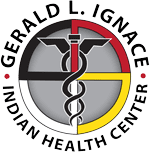Celebrating Fifty Years of Service to the Community.
Gerald Ignace was a young physician by the time he became a father and began sowing the seeds of what would become the Milwaukee Indian Health Clinic.
His son Lyle Ignace was about 4 by the time the clinic was established in a two-room office in 1973.
As Gerald Ignace guided the clinic through its early growth, he nurtured his son in the values he learned from his parents on the Coeur d’Alene Indian reservation in northern Idaho, and the Jesuit missionaries who served as his teachers: hard work and education.
“My Parents stressed education from the time I can remember. They saw what a lack of education did to devastate families,” said Ignace, whose son, now a physician himself, is executive director of the clinic, now the Gerald L. Ignace Indian Health Center, Inc. on Milwaukee’s south side.
Gerald Ignace will be honored Friday for his half-century of service to the health care needs of Milwaukee’s Native American population at the clinic’s 14th Annual Red Shawl Gala fundraiser at the Potawatomi Hotel & Casino.
The theme of this year’s gala is “A Legacy of Native Health Under One Roof.”
The theme might be taken literally, as Lyle Ignace, now the clinic’s executive director, could easily be considered his father’s living legacy.
“The seeds for our center grew from awareness in the 1970s of the poor health among Milwaukee’s Native American community,” said Lyle Ignace, a member of both the Menominee Indian Tribe of Wisconsin and the Coeur d’Alene Tribe of Idaho.
“It is an honor to celebrate and continue my father’s legacy to improve the essential health, peace and well-being of urban Indians in the greater Milwaukee area,” Lyle Ignace said.
After grade school on the reservation, Gerald Ignace attended Gonzaga Preparatory School in Spokane, Wash., before enrolling in Gonzaga University.
“One of the biggest issues I was always worried about was how was all this going to be paid for,” Ignace said in an interview at the clinic, now a sparkling 40,000-square-foot facility at 930 W. Historic Mitchell St.
His father operated road graders, snow plows and other heavy equipment for the Bureau of Indian Affairs, while his mother moved into an apartment in Spokane so her son could attend prep school.
During summers he and his mom moved back to the reservation, and the young Ignace would work in a book bindery.
He received a small scholarship his first year at Gonzaga University, spending summers fighting fires and protecting giant white pines against blister rust in the St. Joe National Forest.
At Gonzaga, Ignace carried 21 credits in the university’s pre-med program for four straight years.
“It was hard, grueling work,” he remembered.
After earning his bachelor’s degree in basic medical science Ignace continued his Jesuit education at Marquette University Medical School, earning his medical degree at age 25.
“If there were obstacles I never recognized them,” Ignace said.
After a residency at what was then Milwaukee County General Hospital, Ignace served in the federal Indian Health Service, working in Shiprock, N.M., on the Navajo Indian Reservation.
He then worked as a clinical instructor at the Medical College of Wisconsin before entering private practice at Harwood Medical Associates in Wauwatosa in 1972.
“By that time I saw that more Indian people were moving to cites, so that’s where I wanted to practice,” Ignace recalled, citing the cultural and economic difficulties urban Native Americans faced when trying to access health care.
“There was just as much need as on the reservation.”
Ignace and other local Native Americans formed the Milwaukee Indian Health Board and Health Clinic in 1973 with a $60,000 grant from the Indian Health Service.
Since then he remained in private practice, specializing in internal medicine at Harwood, Covenant Health Care and now Ascension Wisconsin, also serving as chair for the Indian Health Board and Clinic from 1974 to 1984.
“Indian people needed to see an Indian face when they sought health care,” Ignace said.
“We put together a place where Indian people are taking care of the health needs of Indian people.”
Today the clinic is a multi-million dollar facility in a renovated building that once housed Goldmann’s department store, offering a multitude of traditional and culturally specific services to both Native and non-Native Americans.
Ignace gives much of the credit for the clinic’s growth and success to both the medical and administrative expertise of his son.
“He makes both me and my wife very happy that he is our son,” Ignace said.
“The clinic is in very good hands.”
Original article written by Jesse Garza of the Milwaukee Journal Sentinel.
